Waste Landscape: Urban Regeneration Process for Shared Scenarios
Abstract
:1. Introduction
2. Materials and Methods
2.1. Knowledge Process
2.2. Alternative Scenario Development Process
- Alternative 1. Cultural and Creative Community Hub;
- Alternative 2. Natural and Commercial Community Hub;
- Alternative 3. Virtual and Virtuous Community Hub
2.3. Evaluation Process
2.3.1. The NAIADE Method: Bottom-Up Approach for Evaluating Stakeholder Preferences
- −
- A multi-criteria analysis, which, on the basis of the impact matrix, leads to the definition of the priorities of an alternative scenario to certain decision-making criteria;
- −
- An equity analysis, which, on the basis of the equity matrix, analyzes possible “alliances” or “conflicts” between different interests in relation to the scenarios in question. This information is essential for DMs to reach a higher level of consensus among stakeholders, thus ensuring more effective implementation of their plans.
2.3.2. The PROMETHEE Method: A Top-Down Approach to Evaluation
3. A Multidimensional Decision-Making Process for Urban Regeneration
3.1. Sustainability Indicators as Tools for Evaluating the Alternatives
- Goal 9. “Industry, innovation, and infrastructure”: Building resilient infrastructures, promoting sustainable and inclusive industrialization, and fostering innovation and the creation of new jobs. Both infrastructures and especially the cultural industry are important to support the entire economic development and our well-being by becoming sustainable and reliable with technological development and research.
- Goal 11. “Sustainable cities and communities”: Make cities and communities safe, inclusive, resilient, and sustainable. The environment around us can drastically affect our habits and lifestyles. For this reason, the sustainable improvement of our living spaces is an essential goal by 2030.
- Goal 12. “Responsible consumption and production”: Guaranting sustainable consumption and production models, aimed at reducing the ecological footprint, through the management of natural resources, recycling and waste reduction and the creation of production and supply chains more efficient.
| Domain | Indicators | Description | Goal | Unit | SDGs |
|---|---|---|---|---|---|
| Urban Quality | Urban density | A built area on a total land area | max | % | 11 |
| Functional mixitè | N alternative functional destinations | max | 1–5 | 11 | |
| Distance from local attractors | Distance from primary public services: town hall, school, railway, etc. | min | minutes | 11 | |
| Accessibility and public transport | Pedestrian accessibility to public transport | min | minutes | 11 | |
| Parking areas availability | Parking area extension | max | sqm | 11 | |
| Environment | Renewable energies | Energy production from renewable sources | max | % | 12 |
| Environmental sustainability | Permeable surface area | max | sqm | 12 | |
| Green areas | Presence of public green areas | max | sqm | 12 | |
| Rehabilitation polluted areas | Areas to be reclaimed | max | % | 12 | |
| Social | Creation social housing | Construction of residences for social use | max | n. | 11 |
| Gentrification | Possible phenomena of gentrification | min | 1–5 | 11 | |
| Creation of attractive public functions | Attractiveness of public functions | max | 1–5 | 11 | |
| Sports and recreational activities | Recreational attraction | max | 1–5 | 11 | |
| Creation of new jobs | Creation of new jobs | max | n. | 9 | |
| Real estate market | Real estate market prices | max | % | 9 | |
| Economics | Potential of economic development | Interconnections and synergies with local economic activities | max | 1–5 | 9 |
| Investment costs | Investment costs | min | €/sqm | 9 | |
| Management costs | Maintenance costs | min | 1–5 | 9 | |
| Financial appeal for private investors | Attractiveness of private investors | max | 1–5 | 9 |
3.2. Involvement of Stakeholders within the Urban Transformation Process
- Promoters—representatives of institutions operating in the area, those who, thanks to their representativeness, have an influence in the choices of the common good and on final decisions;
- Experts—scholars and researchers representing scientific knowledge, who with their knowledge, skills, and support institutions in making choices;
- Operators—dominant in the cultural and productive sectors, organized local groups and the influential world of associations, which have a strong influence in the choices regarding regenerative processes;
- Users—residents, workers and tourists, representatives of common knowledge, who have strong interest but a low influence, but who must be involved as recipients of final public policies.
- −
- an online questionnaire, through the social network Facebook, was structured in three parts: a first part, aimed at defining the sample structure of the interviewees; a second, dedicated to focusing on the strengths and weaknesses of the WLS under study, according to the perception of the stakeholders; a third, aimed at identifying some guidelines for the implementation of a shared development strategy;
- −
- interviews with preferential actors, representative of each stakeholder group, conducted during some focuses and structured for the exploration of preferences based on a CATWOE approach a technique, developed in the context of Soft System Methodology [69,70,71] which allows to focus on the different aspects of a problem and to define design solutions that meet the expectations of the various stakeholders. It is a simple check-list, useful for understanding the various issues of interest to each stakeholder group and for identifying a shared and effective development strategy. The check-list was organized by targeted questions according to the different types of Stakeholder and different points of view. The model, typical of the CATWOE approach, was improved through the introduction of two further aspects, strengths and weaknesses, in order to directly define the problem and integrate the available information.
4. Results
4.1. The NAIADE Results
- -
- structuring of the equity matrix, based on a participatory approach;
- -
- calculation of the similarity matrix;
- -
- construction of a dendrogram, representing graphically possible “alliances” or “conflicts” between stakeholder groups.
4.2. The PROMETHEE Results
5. Discussion
6. Conclusions
Author Contributions
Funding
Institutional Review Board Statement
Informed Consent Statement
Data Availability Statement
Conflicts of Interest
References
- Berger, A. Drosscape, Wasting Land in Urban AMERICA; Princeton: New York, NY, USA, 2006. [Google Scholar]
- Lynch, K. Wasting Away; Southworth, M., Ed.; Sierra Club Books: San Francisco, CA, USA, 1990. [Google Scholar]
- Zapata, M.J.; Hall, M. Organising Waste in the City; Policy Press: Bristol, UK, 2013. [Google Scholar]
- European Commission. Getting Cultural Heritage to Work for Europe. Report of the Horizon 2020 Expert Group on Cultural Heritage, Brussels. 2015. Available online: https://op.europa.eu/en/publication-detail/-/publication/b01a0d0a-2a4f-4de0-88f7-85bf2dc6e004/language-en/format-PDF/source-251854419 (accessed on 12 December 2021).
- De Certeau, M. L’Invention du Quotidien—Volume 1, Arts de Faire; Union Générale D’éditions: Paris, France, 1980. [Google Scholar]
- Arampatzi, A. The spatiality of counter-austerity politics in Athens, Greece: Emergent urban solidarity spaces. Urban Stud. 2017, 54, 2155–2171. [Google Scholar] [CrossRef]
- Ghose, R.; Pettygrove, M. Urban community gardens as spaces of citizenship. Antipode 2014, 46, 1092–1112. [Google Scholar] [CrossRef]
- Vitale, T. Building a shared interest. Olinda Milan: Social innovation between strategy and organizational learning. In Can Neighbourhoods Save the City? Community Development and Social Innovation; Moulaert, F., Swyngedouw, E., Martinelli, F., Gonzalez, S., Eds.; Routledge: New York, NY, USA; London, UK, 2010; pp. 81–92. [Google Scholar]
- DeGuzman, G.V.; Tang, A.I. Working in the Unoffice: A Guide to Coworking for Indie Workers, Small Businesses, and Nonprofits; NightOwlsPress: San Francisco, CA, USA, 2011. [Google Scholar]
- Spinuzzi, C. Working alone together: Coworking as emergent collaborative activity. J. Bus. Tech. Commun. 2012, 26, 399–441. [Google Scholar] [CrossRef] [Green Version]
- Oldenburg, R. The Great Good Place; Paragon House: New York, NY, USA, 1989. [Google Scholar]
- Capdevila, I. Co-working spaces and the localised dynamics of innovation in Barcelona. Int. J. Innov. Manag. 2015, 19, 1–28. [Google Scholar] [CrossRef]
- Furnari, S. Interstitial Spaces: Microinteraction Settings and the Genesis of New Practices Between Institutional Fields. Acad. Manag. Rev. 2014, 39, 439–462. [Google Scholar] [CrossRef]
- Gill, R.; Pratt, A.C.; Virani, T.E. (Eds.) Creative Hubs in Question: Place, Space and Work in the Creative Economy; Palgrave Macmillan: London, UK, 2019. [Google Scholar]
- Montanari, F.; Mizzau, L. Laboratori Urbani. Organizzare la Rigenerazione Urbana Attraverso la Cultura e L’innovazione Sociale; Fondazione Brodolini: Rome, Italy, 2015; p. 15. [Google Scholar]
- Venturi, P.; Zandonai, F. Dove. La Dimensione di Luogo Che Ricompone Impresa e Società; Egea: Milano, Italy, 2019. [Google Scholar]
- Fordham, G. Made to Last; Joseph Rowntree Foundation: York, UK, 1995. [Google Scholar]
- Arthurson, K. Redevelopment of public housing estates: The Australian experience. Urban Policy Res. 1998, 11, 35–46. [Google Scholar] [CrossRef]
- TWI2050. The World in 2050. The Digital Revolution and Sustainable Development: Opportunities and Challenges; Report Prepared by the World in 2050 Initiative; International Institute for Applied Systems Analysis (IIASA): Laxenburg, Austria, 2019. [Google Scholar]
- Cilliers, P. Complexity and Postmodernism: Understanding Complex Systems; Routledge: London, UK, 1998. [Google Scholar] [CrossRef]
- Heylighen, F. The science of self-organization and adaptivity. In Knowledge Management, Organizational Intelligence and Learning, and Complexity; Kiel, L.D., Ed.; Encyclopedia of Life Support Systems (EOLSS) Publishers Co Ltd.: Oxford, UK, 2001. [Google Scholar]
- Funtowicz, S.O.; Martinez-Alier, J.; Munda, G.; Ravetz, J. Multicriteria-based environmental policy. In Implementing Sustainable Development; Abaza, H., Baranzini, A., Eds.; UNEP/Edward Elgar: Cheltenham, UK, 2002; pp. 53–77. [Google Scholar]
- Bobbio, L. A Più Voci. Amministrazioni Pubbliche, Imprese, Associazioni e Cittadini Nei Processi Decisionali Inclusivi; Edizioni Scientifiche Italiane: Naples, Italy, 2004. [Google Scholar]
- Fusco Girard, L. Creative evaluations for a human sustainable planning. In Making Strategies in Spatial Planning; Springer: Berlin/Heidelberg, Germany, 2010; pp. 305–327. [Google Scholar]
- MacArthur, E. Towards the Circular Economy, Economic and Business Rationale for an Accelerated Transition; Ellen MacArthur Foundation: Cowes, UK, 2013. [Google Scholar]
- Wijkman, A.; Skånberg, K. The Circular Economy and Benefits for Society; Club of Rome: Winterthur, Switzerland, 2015. [Google Scholar]
- Ghisellini, P.; Cialani, C.; Ulgiati, S. A review on circular economy: The expected transition to a balanced interplay of environmental and economic systems. J. Clean. Prod. 2016, 114, 11–32. [Google Scholar] [CrossRef]
- Della Spina, L.; Rugolo, A. A Multicriteria Decision Aid Process for Urban Regeneration Process of Abandoned Industrial Areas. In New Metropolitan Perspectives. NMP 2020. Smart Innovation, Systems and Technologies; Bevilacqua, C., Calabrò, F., Della Spina, L., Eds.; Springer: Cham, Switzerland, 2021; Volume 178. [Google Scholar] [CrossRef]
- Cerreta, M.; de Toro, P. Integrated Spatial Assessment (ISA): A Multi-Methodological Approach for Planning Choices. In Advances in Spatial Planning; Burian, J., Ed.; IntechOpen: Rijeka, Croatia, 2012; pp. 77–108. Available online: https://www.intechopen.com/books/advances-in-spatial-planning/integrated-spatial-assessment-isa-a-multi-methodological-approach-for-planning-choices (accessed on 20 December 2019).
- Della Spina, L. Multidimensional Assessment for “Culture-Led” and “Community-Driven” Urban Regeneration as Driver for Trigger Economic Vitality in Urban Historic Centers. Sustainability 2019, 11, 7237. [Google Scholar] [CrossRef] [Green Version]
- Della Spina, L.; Giorno, C.; Galati Casmiro, R. Bottom-Up Processes for Culture-Led Urban Regeneration Scenarios. In Proceedings of the International Conference on Computational Science and Its Applications—ICCSA 2019; Lecture Notes in Computer Science, Saint Petersburg, Russia, 1–4 July 2019; Misra, S., Gervasi, O., Murgante, B., Stankova, E., Korkhov, V., Torre, C., Rocha, A.M.A.C., Taniar, D., Apduhan, B.O., Tarantino, E., Eds.; Springer: Cham, Switzerland, 2019; Volume 11622, pp. 93–107. [Google Scholar] [CrossRef]
- Ostrom, E. Institutional Rational Choice: An Assessment of the Institutional Analysis and Development Framework. In Theories of the Policy Process; Sabatier, P.A., Ed.; Westview Press: Boulder, CO, USA, 1999. [Google Scholar]
- Woodhill, J. Shaping behaviour: How institutions evolve. Broker 2008, 10, 4–8. [Google Scholar]
- Wilson, K.; Morren, G.E.B., Jr. Systems Approaches for Improvement in Agriculture and Resource Management; Macmillan Publishing Company: New York, NY, USA, 1990. [Google Scholar]
- Schmeer, K. Stakeholder analysis guidelines. In Policy Toolkit for Strengthening Health Sector Reform; World Bank: Washington, DC, USA, 1999. [Google Scholar]
- Wasserman, S.; Faust, K. Social Network Analysis: Methods and Applications; Cambridge University Press: New York, NY, USA, 1994. [Google Scholar]
- Perchinunno, P.; Rotondo, F.; Torre, C.M. A multivariate fuzzy analysis for the regeneration of urban poverty areas. In Proceedings of the International Conference on Computational Science and Its Applications—ICCSA 2008; LNCS, Perugia, Italy, 30 June–3 July 2008; Gervasi, O., Murgante, B., Laganà, A., Taniar, D., Mun, Y., Gavrilova, M.L., Eds.; Springer: Heidelberg, Germany, 2008; Volume 5072, pp. 137–152. [Google Scholar] [CrossRef]
- Munda, G. Social multi-criteria evaluation (SMCE): Methodological foundations and operational consequences. Eur. J. Oper. Res. 2004, 158, 662–677. [Google Scholar] [CrossRef]
- Gamboa, G.; Munda, G. The problem of windfarm location: A social multi-criteria evaluation framework. Energy Policy 2007, 35, 1564–1583. [Google Scholar] [CrossRef]
- Munda, G. Multicriteria Evaluation in a Fuzzy Environment: Theory and Applications in Ecological Economics; Physica-Verlag: Heidelberg, Germany, 1995. [Google Scholar]
- Ackermann, F.; Eden, C. Strategic management of stakeholders: Theory and practice. Long Range Plan. 2011, 44, 179–196. [Google Scholar] [CrossRef]
- Bana e Costa, C.A. Readings in Multiple Criteria Decision Aid; Springer: Berlin, Germany, 1990. [Google Scholar]
- Mareschal, B. Visual PROMETHEE 1.4 Manual. 2013. Available online: www.promethee-gaia.net (accessed on 20 September 2021).
- Dente, B. Understanding Policy Decisions; Polimi Springer Briefs; Springer: New York, NY, USA, 2014. [Google Scholar]
- Bourne, L.; Walke, D. Project relationship management and the stakeholder circle. Int. J. Manag. Proj. Bus. 2008, 1, 125–130. [Google Scholar] [CrossRef] [Green Version]
- Mareschal, B.; de Smet, Y. Visual PROMETHEE: Developments of the PROMETHEE & GAIA multicriteria decision aid methods. In Proceedings of the 2009 IEEE International Conference on Industrial Engineering and Engineering Management, Hong Kong, China, 8–11 December 2009; pp. 1646–1649. [Google Scholar]
- Figueira, J.; Greco, S.; Ehrgott, M. Multiple Criteria Decision Analysis: State of the Art Surveys; Springer Science & Business Media: Berlin, Germany, 2005; Volume 78. [Google Scholar]
- Ishizaka, A.; Nemery, P. Multi-Criteria Decision Analysis: Methods and Software; John Wiley & Sons: Hoboken, NJ, USA, 2013. [Google Scholar]
- Ward, S.; Chapman, C. Stakeholders and uncertainty management in projects. Constr. Manag. Econ. 2008, 26, 563–577. [Google Scholar] [CrossRef]
- Roy, B.; Figueira, J. Détermination des Poids des Critères dans les Méthodes de Type ELECTRE Avec la Technique de SIMOS Révisée; Document du LAMSADE 109; Université de Paris Dauphine: Paris, France, 1998. [Google Scholar]
- Figueira, J.; Roy, B. Determining the weights of criteria in the ELECTRE type methods with a revised Simos’ procedure. Eur. J. Oper. Res. 2002, 139, 317–326. [Google Scholar] [CrossRef] [Green Version]
- Ellen MacArthur Foundation. Cities in the Circular Economy: An Initial Exploration; Ellen MacArthur Foundation: Sail Loft, UK, 2017. [Google Scholar]
- United Nations (UN). Agenda 21. In Proceedings of the United Nations Conference on Environment & Development, Rio de Janerio, Brazil, 3–14 June 1992; Available online: https://sustainabledevelopment.un.org/content/documents/Agenda21.pdf (accessed on 12 October 2021).
- United Nations (UN). 66/288. The Future We Want. Resolution Adopted by the General Assembly on 27 July 2012. Available online: https://www.un.org/ga/search/view_doc.asp?symbol=A/RES/66/288&Lang=E (accessed on 12 October 2021).
- Hák, T.; Janoušková, S.; Moldan, B. Sustainable Development Goals: A need for relevant indicators. Ecol. Indic. 2016, 60, 565–573. [Google Scholar] [CrossRef]
- Eurostat. Getting Messages across Using Indicators. A Handbook Based on Experiences from Assessing Sustainable Development Indicators; Eurostat: Luxembourg, 2014. [Google Scholar]
- De Graaf, R.; van der Brugge, R. Transforming water infrastructure by linking water management and urban renewal in Rotterdam. Technol. Forecast. Soc. Chang. 2010, 77, 1282–1291. [Google Scholar] [CrossRef]
- Rijke, J.; Farrelly, M.; Morison, P.; Brown, R.; Zevenbergen, C. Towards improved urban water governance in Adelaide, Australia. In Proceedings of the 12th International Conference on Urban Drainage, Porto Alegre, Brazil, 11–16 September 2011; pp. 11–16. [Google Scholar]
- Waddock, S. Integrity and mindfulness: Foundations of corporate citizenship. In Perspectives on Corporate Citizenship; Andriof, J., McIntosh, M., Eds.; Greenleaf Publishing: Sheffield, UK, 2001; pp. 25–38. [Google Scholar]
- Burchell, J.; Cook, J. Stakeholder dialogue and organisational learning: Changing relationships between companies and NGOs. Bus. Ethics Eur. Rev. 2008, 17, 35–46. [Google Scholar] [CrossRef]
- Burchell, J.; Cook, J. CSR, Co-optation and Resistance: The Emergence of New Agonistic Relations Between Business and Civil Society. J. Bus. Ethics 2013, 115, 741–754. [Google Scholar] [CrossRef]
- McNamee, S.; Gergen, K.J. (Eds.) Relational Responsibility: Resources for Sustainable Dialogue; Sage Publications, Inc.: Newbury Park, CA, USA, 1999. [Google Scholar]
- Greenwood, M. Stakeholder Engagement: Beyond the Myth of Corporate Responsibility. J. Bus. Ethics 2007, 74, 315–327. [Google Scholar] [CrossRef]
- Danker, M. Understanding Stakeholder Activism, Managing Transparency Risk. In The Governance of Risk (Developments in Corporate Governance and Responsibility; Crowther, D., Aras, G., Eds.; Emerald Group Publishing Limited: Bingley, UK, 2013; Volume 5, pp. 33–72. [Google Scholar]
- Esben Rahbek Pedersen, E.R. Making Corporate Social Responsibility (CSR) Operable: How Companies Translate Stakeholder Dialogue into Practice. Bus. Soc. Rev. 2006, 11, 137–163. [Google Scholar] [CrossRef]
- Van de Ven, A.H.; Poole, M.S. Alternative approaches for studying organizational change. Organ. Stud. 2005, 26, 1377–1404. [Google Scholar] [CrossRef] [Green Version]
- Nared, J.; Bole, D. (Eds.) Participatory Research and Planning in Practice; Springer: Berlin, Germany, 2020. [Google Scholar]
- Checkland, P.B. Soft Systems Methodology. In Rational Analysis for a Problematic World Revisited; Rosenhead, J., Mingers, J., Eds.; John Wiley and Sons: Chichester, UK, 2001. [Google Scholar]
- Rosenhead, J.; Mingers, J. Rational Analysis for a Problematic World Revisited: Problem Structuring Methods for Complexity, Uncertainty and Conflict; John Wiley and Sons: Chichester, UK, 2001. [Google Scholar]
- Mulder, P. CATWOE Analysis. Retrieved from ToolsHero. 2017. Available online: https://www.toolshero.com/problem-solving/catwoe-analysis/ (accessed on 23 January 2022).
- Della Spina, L.; Giorno, C. Cultural Landscapes: A Multi-Stakeholder Methodological Approach to Support Widespread and Shared Tourism Development Strategies. Sustainability 2021, 13, 7175. [Google Scholar] [CrossRef]
- Paskaleva, K.; Cooper, I. Open innovation and the evaluation of internet-enabled public services in smart cities. Technovation 2018, 78, 4–14. [Google Scholar] [CrossRef] [Green Version]
- Strati, F. Apprendimento Reciproco Nelle Strategie Europee: Metodo Aperto di Coordinamento e Scambio di Buone Pratiche. In Dare Valore alle Pratiche, Economia Sociale e Formazione Continua per lo Sviluppo del Territorio; Esperienze EQUAL in Europa: Trento, Italia, 2008; Available online: http://www.srseuropa.eu/publications/f.strati.MOC.libro%20Trento.pdf (accessed on 18 January 2020).
- Ostrom, E. Governare i Beni Collettivi; Marsilio: Venezia, Italia, 2006. [Google Scholar]
- Fusco Girard, L. Risorse Architettoniche e Ambientali; Valutazioni e Strategie di Conservazione; Angeli: Milano, Italia, 1987. [Google Scholar]
- Fusco Girard, L.; Nijkamp, P. Le Valutazioni per lo Sviluppo Sostenibile della Città e del Territorio; Angeli: Milano, Italy, 1997. [Google Scholar]
- Voß, J.P.; Kemp, R. Sustainability and Reflexive Governance: Introduction. In Reflexive Governance for Sustainable Development; Voß, J.P., Bauknecht, D., Kemp, R., Eds.; Edward Elgar Publishing: Cheltenham, UK, 2006; pp. 3–28. [Google Scholar]
- N-Habitat. State of the World’s Cities Report 2004/2005. Globalization and Urban Culture; Earthscan: London, UK, 2004. [Google Scholar]
- United Nations. Transforming Our World: The 2030 Agenda for Sustainable Development. 2015. Available online: www.sustainabledevelopment.un.org (accessed on 27 December 2021).
- United Nations. HABITAT III. Draft New Urban Agenda. 2016. Available online: https://habitat3.org/ (accessed on 29 January 2022).
- DESA—Department of Economic and Social Affairs of the United Nations Secretariat. World Urbanization Prospects—The 2014 Revisions; United Nations: New York, NY, USA, 2014. [Google Scholar]
- The EU Green Deal Explained. Available online: https://www.nortonrosefulbright.com/en/knowledge/publications/c50c4cd9/the-eu-green-deal-explained (accessed on 29 January 2022).
- Mercer, C. Cultural Planning for Urban Development and Creative Cities. 2006. Available online: http://www.burgosciudad21.org/adftp/Shanghai_cultural_planning_paper.pdf (accessed on 29 October 2021).
- Zamagni, S.; Sacco, P. Teoria Economica e Relazioni Interpersonali; Il Mulino: Bologna, Italy, 2006. [Google Scholar]
- Sacco, P.L.; Crociata, A. A conceptual regulatory framework for the design and evaluation of complex, participative cultural planning strategies. Int. J. Urban Reg. Res. 2013, 37, 1688–1706. [Google Scholar] [CrossRef]
- Della Spina, L. Strategic Planning and Decision Making: A Case Study for the Integrated Management of Cultural Heritage Assets in Southern Italy. In Proceedings of the International Symposium New Metropolitan Perspectives—NMP 2020; Smart Innovation, Systems and Technologies, Reggio Calabria, Italy, 26–28 May 2020; Bevilacqua, C., Calabrò, F., Della Spina, L., Eds.; Springer: Cham, Switzerland, 2021; Volume 178. [Google Scholar] [CrossRef]
- Della Spina, L.; Giorno, C.; Galati Casmiro, R. An Integrated Decision Support System to Define the Best Scenario for the Adaptive Sustainable Re-Use of Cultural Heritage in Southern Italy. In Proceedings of the International Symposium New Metropolitan Perspectives—NMP 2020; Smart Innovation, Systems and Technologies, Reggio Calabria, Italy, 26–28 May 2020; Bevilacqua, C., Calabrò, F., Della Spina, L., Eds.; Springer: Cham, Switzerland, 2020; Volume 177. [Google Scholar] [CrossRef]
- Della Spina, L.; Scrivo, R.; Ventura, C.; Viglianisi, A. Urban renewal: Negotiation procedures and evaluation models. In Proceedings of the ICCSA 2015—International Conference on Computational Science and Its Applications, Banff, AB, Canada, 22–25 June 2015; Gervasi, O., Murgante, B., Misra, S., Gavrilova, M.L., Rocha, A.M.A.C., Torre, C., Taniar, D., Apduhan, B.O., Eds.; Springer: Cham, Switzerland, 2015; Volume 9157, pp. 88–103. [Google Scholar]
- Mukhtar-Landgren, D.; Kronsell, A.; Voytenko Palgan, Y.; von Wirth, T. Municipalities as enablers in urban experimentation. J. Environ. Policy Plan. 2019, 21, 718–733. [Google Scholar] [CrossRef] [Green Version]
- Council of Europe. Council of Europe Framework Convention on the Value of Cultural Heritage for Society; Faro: Lake Mary, FL, USA, 2005. [Google Scholar]
- ENoLL (European Network of Living Labs). Available online: https://enoll.org/ (accessed on 30 July 2021).
- Chesbrough, H.; Vanhaverbeke, W.; West, J. Open Innovation: Researching a New Paradigm; Oxford University Press on Demand: Oxford, UK, 2006; ISBN 0199290725. [Google Scholar]
- Seravalli, G. Innovazione e Sviluppo Locale; Concetti, Esperienze, Politiche, WP 7/2007 Serie: Economia e Politica Economica. Available online: http://www.swrwebeco.unipr.it/RePEc/pdf/I_2007-07.pdf (accessed on 10 January 2022).
- Zamagni, S. Dal Welfare Della Delega al Welfare Della Partecipazione; Il Distretto di Cittadinanza Come Esempio Evoluto di Sussidiarietà Circolare; Le Giornate di Bertinoro per l’Economia Civile. Available online: https://ordosocialis.de/pdf/Zamagni/DAL%20WELFARE%20DELLA%20DELEGA%20AL%20WELFARE%20DELLA%20PARTECIPAZIONE.pdf (accessed on 10 February 2021).
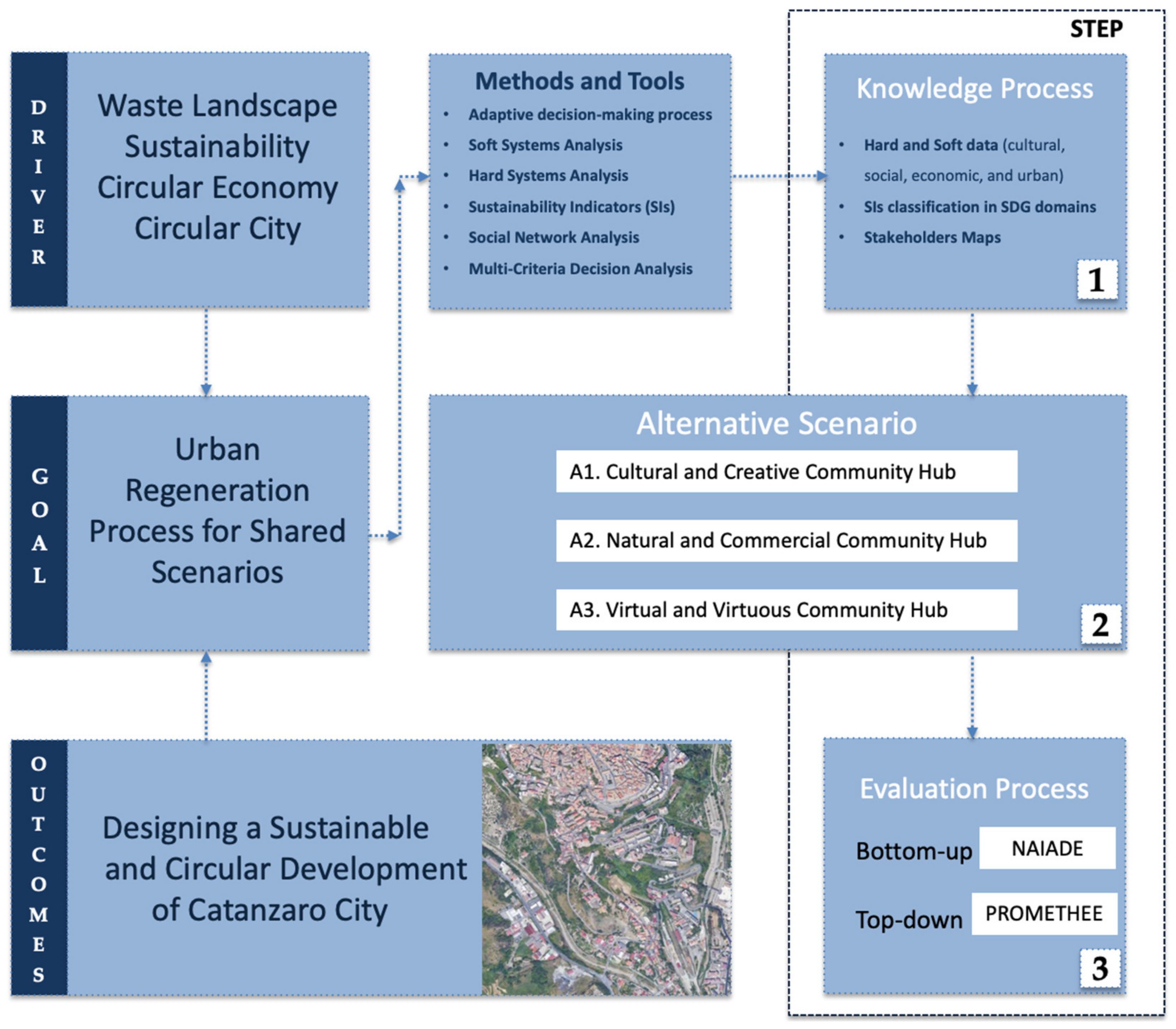
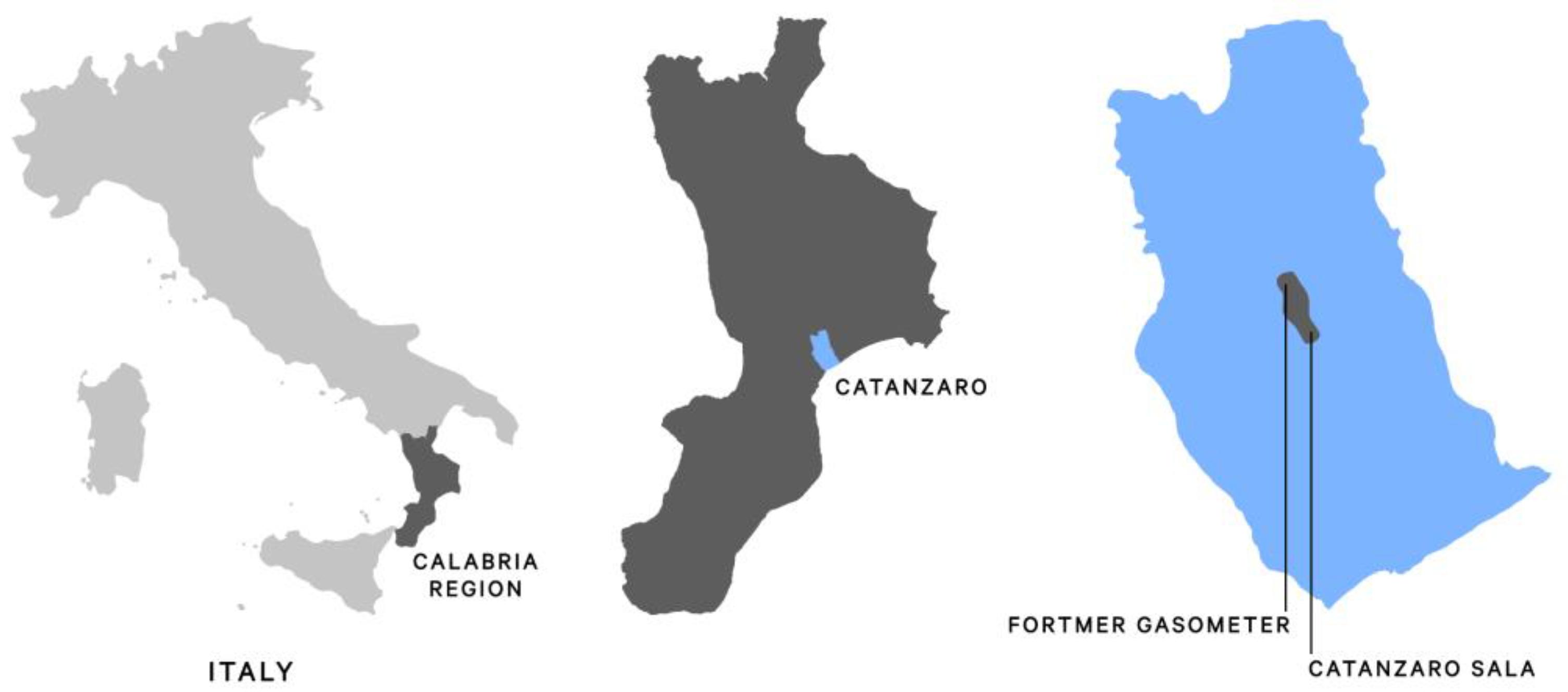
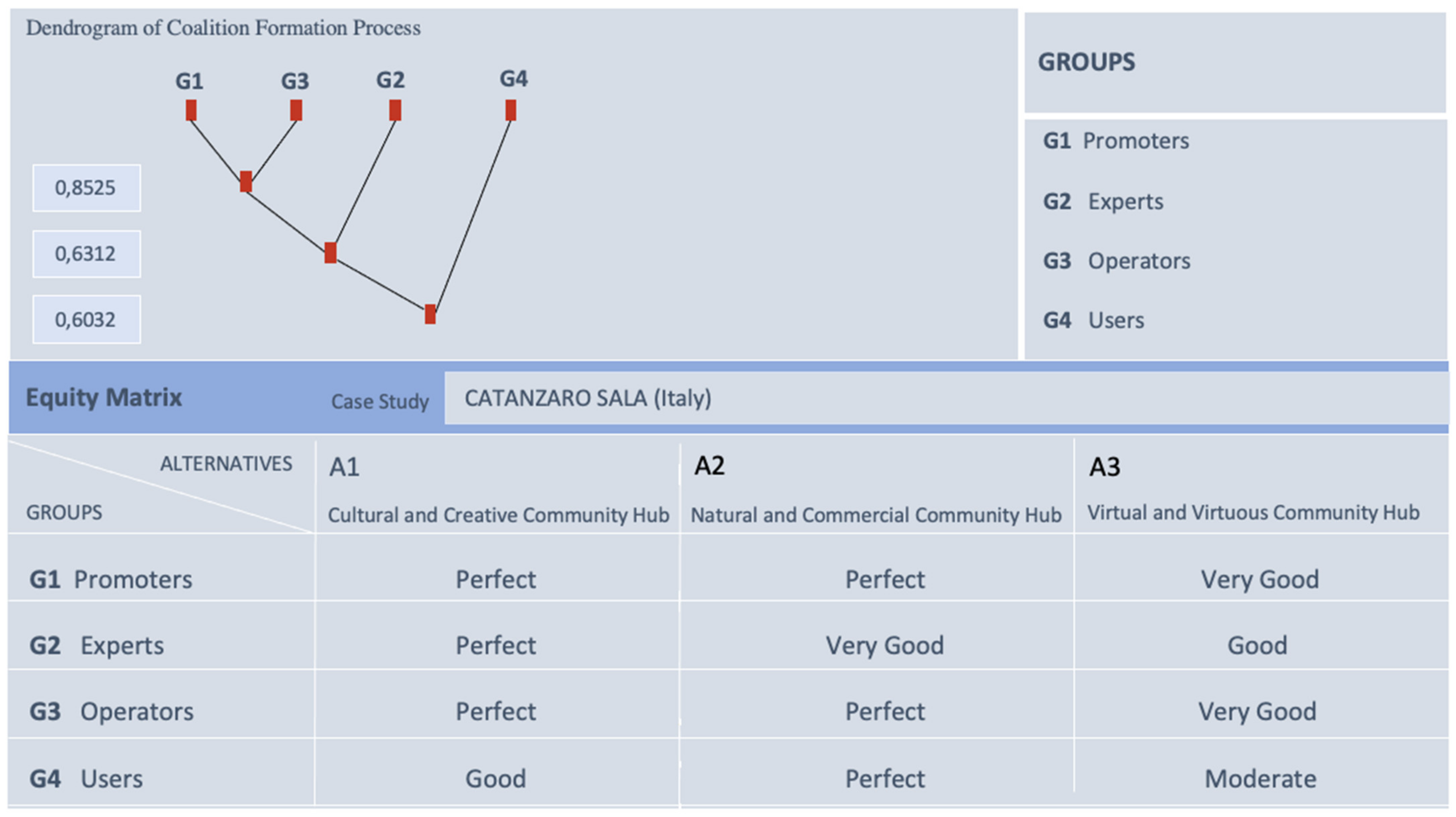
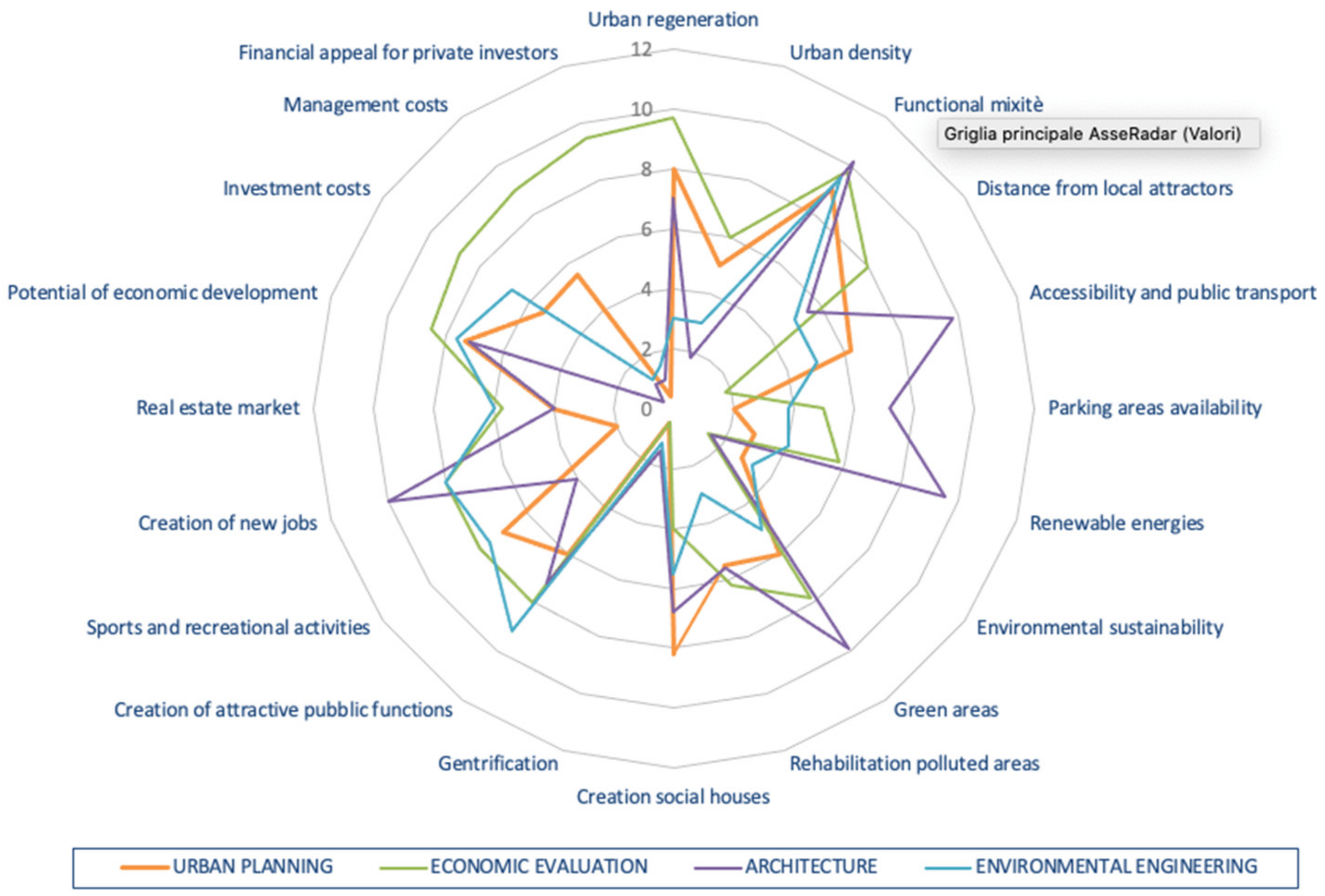
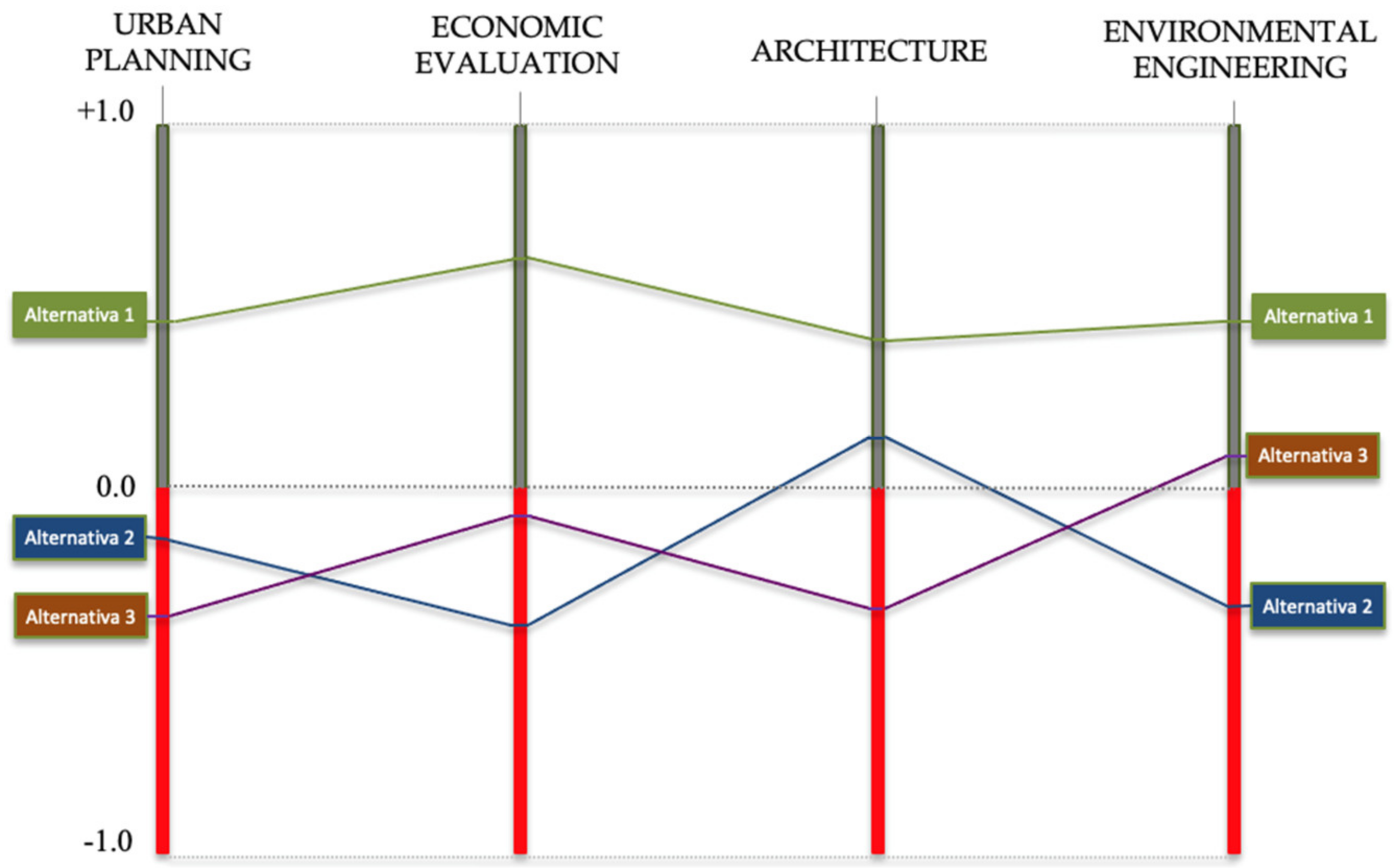
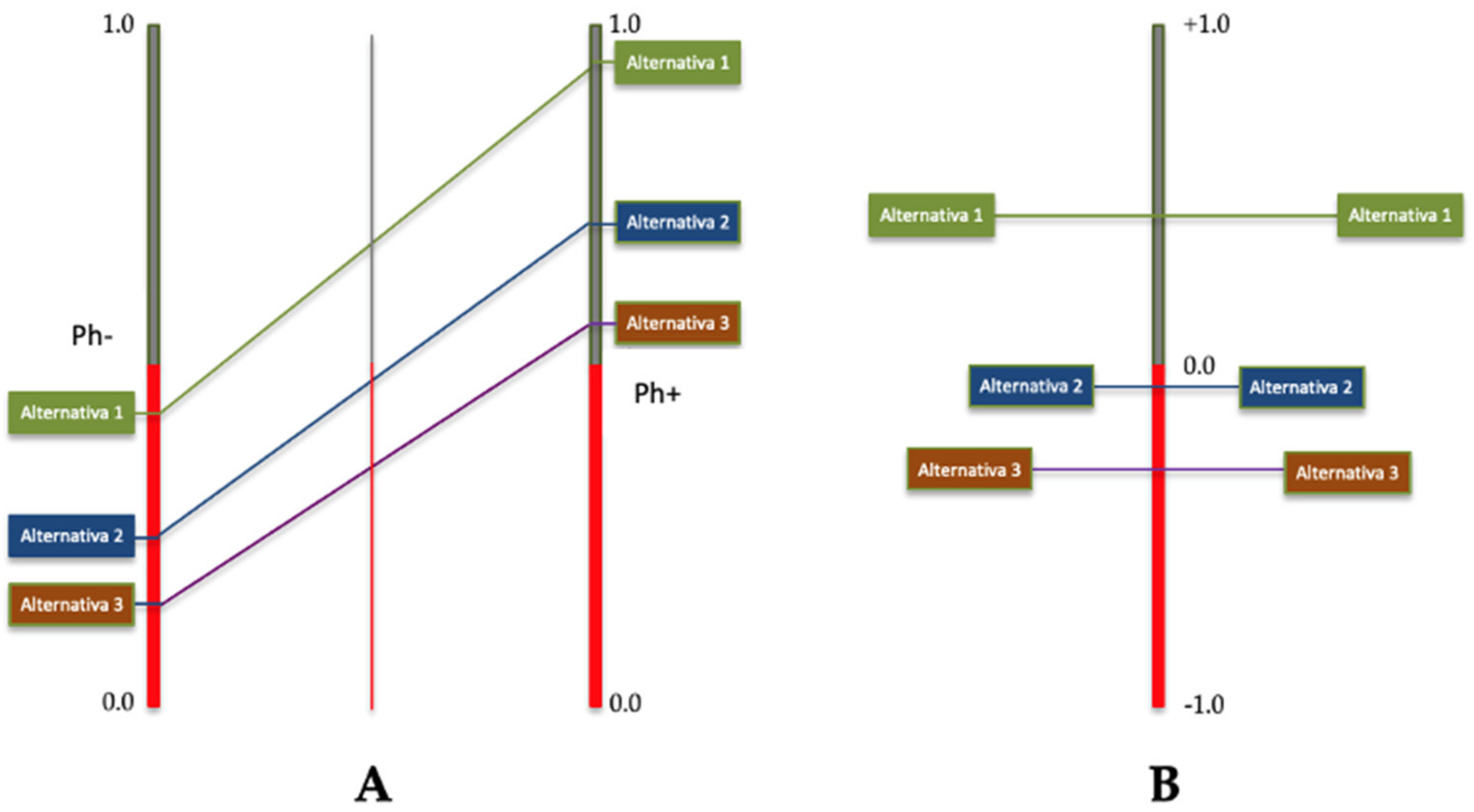
|
|
|
|
|
|
|
|
|
| Criteria MCDA | Degree of Compensation Allowed Among the Criteria | Modeling of DM Preferences | Ease of Use | Ability to Spport a Large Number of Decision-Makers | Ability to Manage Many Criteria and Alternatives | Treatment of Inaccurate or Uncertain Criteria | Interpretation of Software Parameters |
|---|---|---|---|---|---|---|---|
| NAIADE | ++ | SI | ++ | ++ | +++ | +++ | −− |
| PROMETHEE | ++ | NO | −− | ++ | ++ | ++ | + |
Publisher’s Note: MDPI stays neutral with regard to jurisdictional claims in published maps and institutional affiliations. |
© 2022 by the authors. Licensee MDPI, Basel, Switzerland. This article is an open access article distributed under the terms and conditions of the Creative Commons Attribution (CC BY) license (https://creativecommons.org/licenses/by/4.0/).
Share and Cite
Della Spina, L.; Giorno, C. Waste Landscape: Urban Regeneration Process for Shared Scenarios. Sustainability 2022, 14, 2880. https://doi.org/10.3390/su14052880
Della Spina L, Giorno C. Waste Landscape: Urban Regeneration Process for Shared Scenarios. Sustainability. 2022; 14(5):2880. https://doi.org/10.3390/su14052880
Chicago/Turabian StyleDella Spina, Lucia, and Claudia Giorno. 2022. "Waste Landscape: Urban Regeneration Process for Shared Scenarios" Sustainability 14, no. 5: 2880. https://doi.org/10.3390/su14052880
APA StyleDella Spina, L., & Giorno, C. (2022). Waste Landscape: Urban Regeneration Process for Shared Scenarios. Sustainability, 14(5), 2880. https://doi.org/10.3390/su14052880







